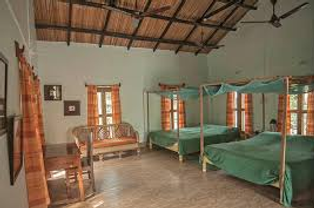
Sundarban National Park – A Comprehensive Guide

About - Sundarban National Park
Located in the vast delta of the Ganges, Brahmaputra, and Meghna rivers, Sundarbans National Park is a UNESCO World Heritage Site and one of the most unique ecosystems in the world. This mangrove forest spans across West Bengal, India, and Bangladesh, and is the largest estuarine forest in the world.
The Sundarbans is famous for its Royal Bengal Tigers, adapted to the mangrove habitat, and its intricate network of rivers, creeks, and islands. Declared a National Park in 1984, it covers an area of 1,330 sq. km and plays a vital role in the conservation of biodiversity in India.
The park is also home to a variety of species, including saltwater crocodiles, spotted deer, and gangetic dolphins, attracting researchers, wildlife enthusiasts, and photographers from across the globe.
Geographical Details
-
Altitude: Sea level to 10m above sea level
-
Coordinates: 21°32’ N to 22°40’ N
-
Rainfall: 2,000 mm annually
-
Temperature:
-
Winter: 9°C (Min)
-
Summer: 42°C (Max)
-



How to Reach Sundarbans National Park
By Flight
The nearest airport is Netaji Subhas Chandra Bose International Airport, Kolkata (112 km). From Kolkata, you can hire a taxi or take a train to reach the park’s entry points.
By Train
-
Canning Railway Station (48 km): The nearest railhead to the park.
-
Regular trains are available from Kolkata to Canning, from where you can take a boat or taxi to the Sundarbans.
By Road and Boat
The Sundarbans can be accessed via road and boat from Kolkata:
-
Godkhali: 112 km (3-hour drive) from Kolkata. From Godkhali, boats ferry visitors to the park.
-
Regular boat services are available from Namkhana, Canning, and Gosaba.
Best Time to Visit Sundarbans National Park
-
Winter (November – February): The best time for tiger sightings and comfortable weather.
-
Summer (March – May): Ideal for birdwatching and exploring the mangroves.
-
Monsoon (June – September): The park is closed due to heavy rainfall and high tides.
Wildlife at Sundarbans National Park
The Sundarbans is home to diverse flora and fauna, including:
-
Royal Bengal Tiger: Adapted to swimming in the mangroves.
-
Saltwater Crocodile: The largest reptile found in the estuarine waters.
-
Gangetic Dolphin: Frequently spotted in the rivers and creeks.
-
Fishing Cat: A rare and elusive predator of the mangroves.
-
Indian Python: Often spotted basking in the sun near water bodies.
Bird species include:
-
Lesser Adjutant Stork
-
Mangrove Whistler
-
Collared Kingfisher
Marine life includes horseshoe crabs, mudskippers, and various fish species.
Best Places to Visit Inside and Near Sundarbans National Park
-
Sajnekhali Watch Tower
-
A popular spot for observing wildlife and birds, including crocodiles and water monitors.
-
-
Sudhanyakhali Watch Tower
-
Known for frequent tiger sightings and panoramic views of the mangroves.
-
-
Netidhopani
-
A historic site with ancient ruins and a serene environment.
-
-
Dobanki Watch Tower
-
Features a canopy walk offering a bird’s-eye view of the forest.
-
-
Hiron Point
-
A picturesque location ideal for photography and wildlife observation.
-
-
Bhagabatpur Crocodile Project (50 km)
-
A breeding center for saltwater crocodiles near the Sundarbans.
-
-
Kolkata City (112 km)
-
Explore the vibrant city for its cultural heritage, including Victoria Memorial and Howrah Bridge.
-
Types of Safaris in Sundarbans National Park
-
Boat Safari
-
Description: Explore the intricate waterways and mangroves by boat.
-
Timings: Morning and evening safaris available.
-
Capacity: Boats can accommodate small and large groups.
-
-
Walking Safari
-
Description: Guided walks near the buffer zones for birdwatching.
-
-
Canopy Walk
-
Description: A thrilling canopy walk near Dobanki Watch Tower.
-
Safari Zones in Sundarbans National Park
The park is divided into multiple zones, each offering unique experiences:
-
Sajnekhali Zone: Famous for watchtowers and birdwatching.
-
Sudhanyakhali Zone: Known for tiger sightings and scenic mangroves.
-
Dobanki Zone: Offers canopy walks and panoramic views of the forest.
Accommodations in Sundarbans National Park

Sunderban Tiger Camp

Sundarban Riverside Resort

Mangrove Retreat

Sajnekhali Tourist Lodge

Eco Village Sundarbans

Tigerland Resort

Hotel Royal Sundarban Wild Resort

Sundarban Gateway Resort

Backwater Resort Sundarbans

